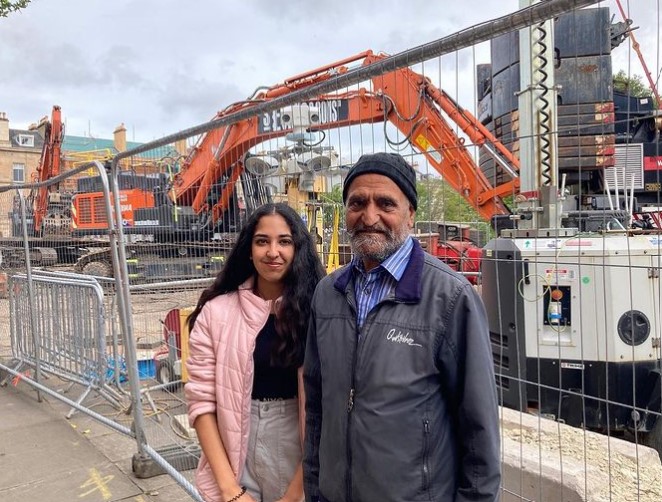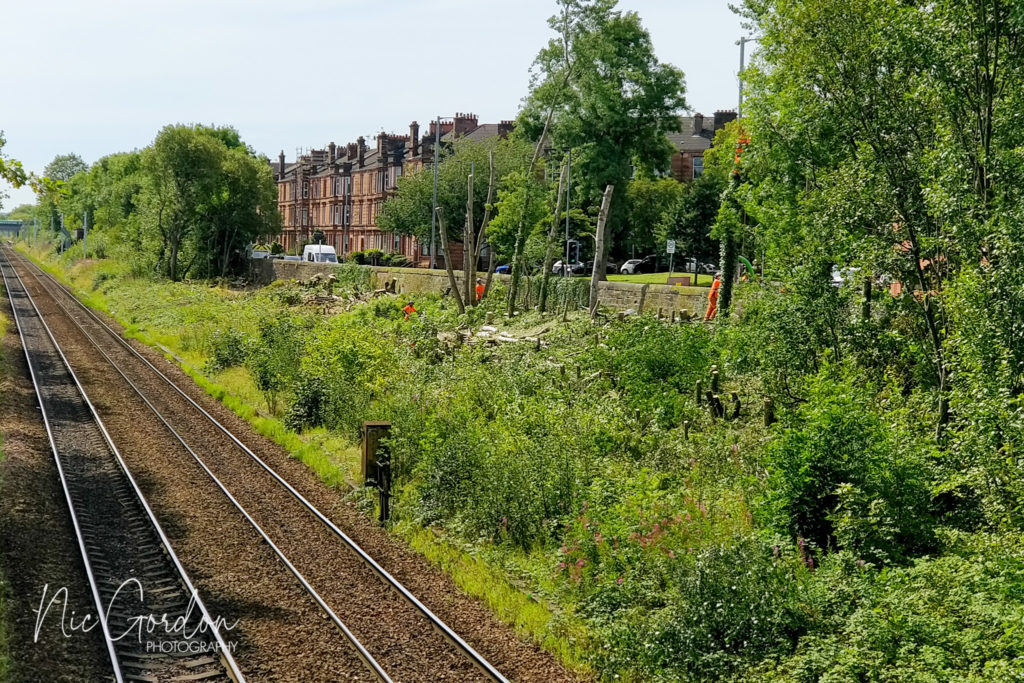It was a busy weekend in the Bungo, bringing the largest changes to the neighbourhood in living memory.
The Booking Hall
Strathbungo Station opened in 1877. The booking hall had stood on the Nithsdale Road bridge ever since, even after the station’s closure in 1962. It finally disappeared last weekend (5th-7th August 2022), followed shortly after by the bridge itself.
The booking hall was a local landmark, and in recent years was better known as Susie’s shop, run by Joe Deo and his family until his recent retirement. Joe was out himself to see the work. You can read the history of Strathbungo Station on BygoneBungo.
The Bridge
The bridge removal was required to allow electrification of the railway line. It was a major civil engineering undertaking and along with works at other locations on the line, had to be completed in one weekend to minimise disruption to the line. Many will have seen the huge crane employed to remove the steel girders of the old bridge. The exercise seemed to go without a hitch, although I have been told it did sever the connection between the Queen Elizabeth University Hospital and several important national IT systems over the weekend – in diverting essential services over the temporary bridge on Moray Place, someone missed a cable somewhere.
The girders for the new bridge are due to be installed this weekend, so expect to see another large crane in the area. Meanwhile modifications have been made to the footbridge to allow step free access for the months that the Nithsdale Road bridge is being reconstructed. Sadly the footbridge will go too in the Spring, and rumours are that no one has yet been found to rescue it from the scrap heap.
Local photographer Nic Gordon recorded the events, and more pictures can be seen on his website.
Tree felling & Works Depot
Network Rail also arrived with chain saws and conducted extensive tree felling on the Darnley Road side of the tracks which caused some alarm and no little environmental destruction, especially as no warning was given about this aspect of the project. It has been difficult to find out what this was all about, and one Twitter user was given a generic response about tree clearance to allow gantry installation which clearly didn’t fit the bill, but we have finally got some detail from Network Rail representatives. They intend to take down a section of the stone wall and use this area for track access and a depot during the works, and will (hopefully) reinstate things once they are done. There are also issues around the presence of Japanese knotweed.
As you know, the primary work in the Strathbungo area for the last few months has been around the bridge at Nithsdale Road and nearby footbridge. Since April we have also been undertaking work along the length of the route from Barrhead to install foundations for the overhead lines, something you had previously sought clarity on following our notification letter in April, specifically around the type of piling this would involve. With the foundation work now reaching the Strathbungo area, this has brought with it some accompanying activity required in order to deliver the work. I’m sorry this wasn’t made clear in our letter in April.
Upcoming work for this activity includes:
15-19 Aug – Dayshift removal of wall section and installation of drop kerb.
20 Aug – Dayshift commencing of site clearance and excavation, including stump removal.
21-26 Aug – Day and nightshift civil works, including delivery of stone, ahead of construction of compound surface.
28-30 Aug – Installation of compound surface.
31 Aug – Dayshift work involving final site walkthrough of compound.
The construction of the compound involves removing a section of the boundary wall, retaining the existing copes, and installing a concrete drop kerb. This will involve the use of an excavator and concrete wagon with small work tools. Once complete, an excavator and dumper truck will be in operation within the de-vegetated area to dig out the compound area, and all materials, soil etc will be stockpiled on site. No soil material will be leaving the site. We do not envision vibrations from these machines impacting on surrounding properties.
From an environmental perspective, the entire area is confirmed as having knotweed contamination which is why no soil will be removed from site. The dumper truck and excavator will remain in the contaminated zone, and will be fully cleaned and inspected before leaving site to ensure they are not contaminated with knotweed. All operatives working within the site will be required to undertake a full boot and PPE wash and inspection when leaving site. A knotweed membrane will be installed for the full extent of the compound area, and a quarantine zone around the stockpiled soil materials. A weekly inspection of the compound surface will take place, but as the growing season for knotweed has now passed, there won’t be any encroachment growth out of the quarantined area. As we approach summer 2023, which is next knotweed growing season, an increased inspection regime will be implemented, primarily inspecting the compound surface for any signs of penetration of the knotweed membrane and growth outwith the quarantine zone.
In terms of noise, this will be at its highest in the final week while we are laying the new stone for the compound surface, which will sit on top of the knotweed membrane. This specific activity takes place nightshift 28-30 Aug, however earth moving machines will be in operation for the duration of the civil works.
In terms of the knotweed treatment plan, this will not commence until the 2023 growing season and involves a spray herbicide over two sessions suitably spaced apart, with a further inspection towards the end of the growing season to review the effectiveness of the treatment. This treatment plan will continue for the next 2 to 3 years. Your concerns have also been passed to our knotweed specialist regarding any impact the herbicides may have on other plants in the surrounding area.
In terms of future environmental management plans for the area, it is intended that the top compound surface will be inspected and removed along with the knotweed membrane. Depending on the results of the inspection, these materials will likely be classified as waste and treated accordingly. A review of the stockpiled soil material will be undertaken to determine if it should be left in place I.e if there has been suitable wilding taken place. The wall will be reinstated with matching stone, rather than engineering brick, and opportunities for biodiversity improvement assessed. The Network Rail environmental team will be involved throughout this process.
We don’t have specific dates for the foundation and stanchion installation, but it should take place at some point between 3-30 Sep.











 #b
#b














knotweed on our doorstep im in QUEEN SQ VERY WORRYING